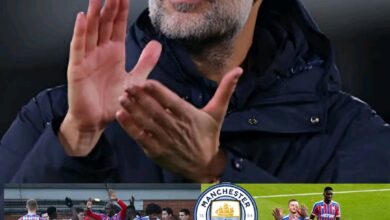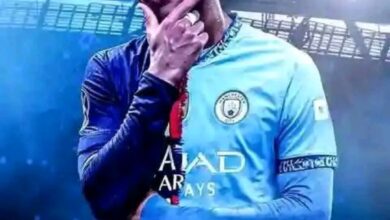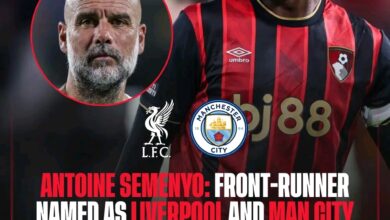Pep Guardiola could sign a ‘genius’ at Man City and give him Jack Grealish’s number 10 shirt next season

Manchester City’s relationship with Jack Grealish has been one of football’s most fascinating case studies in recent years. The English winger, who arrived at the Etihad Stadium in 2021 with a British record transfer fee of £100 million, has struggled to consistently cement his place in Pep Guardiola’s intricate tactical system. As the 2024-25 season draws to a close, questions surrounding his future at the club have intensified, with recent comments from Guardiola himself suggesting that a departure might be beneficial for all parties involved.
The complexity of Grealish’s situation at Manchester City cannot be understated. When he joined from Aston Villa four years ago, he was viewed as one of the Premier League’s most dynamic and creative forces. His ability to beat defenders one-on-one, combined with his knack for drawing fouls in dangerous areas, made him a coveted asset. However, the transition from being the focal point of Villa’s attack to fitting into Guardiola’s collective philosophy has proven more challenging than anticipated.
This season has been particularly testing for the 29-year-old. With only 16 starts across all competitions, Grealish has found himself increasingly on the periphery of City’s plans. The emergence of younger talents and the continued excellence of established stars has created a competitive environment where consistent performance is not just expected but demanded. For a player of Grealish’s caliber and price tag, such limited involvement represents a significant shift in trajectory.
The psychological impact of reduced playing time cannot be ignored. Grealish, who was once Villa’s captain and talisman, has had to adapt to a role where he might not always be the first choice. This adjustment period has been extended and, at times, painful to observe. The player who once terrorized Premier League defenses with his direct running and creativity has had to modify his game to suit a more structured approach, sometimes at the expense of the very qualities that made him special.
Pep Guardiola’s Manchester City operates on principles of positional play, tactical flexibility, and collective intelligence. Within this framework, individual brilliance must serve the greater good of the team’s objectives. For players like Grealish, who built their reputation on moments of individual magic, this can present significant challenges. The Catalan coach’s system demands not just technical excellence but also tactical discipline and positional awareness that some players find restrictive.
The evolution of City’s tactical approach over recent seasons has seen Guardiola experiment with various formations and player roles. The traditional winger position has been reimagined, with players expected to drift inside, create overloads in central areas, and contribute to the team’s pressing structure. This tactical sophistication has brought tremendous success to the club but has also meant that certain player profiles struggle to find their optimal expression within the system.
Grealish’s natural inclination to hold onto the ball, take on defenders, and create moments of unpredictability sometimes conflicts with the quick passing combinations and structured attacks that Guardiola prefers. While the manager has publicly praised Grealish’s qualities and his contribution to the team’s success, including their treble-winning campaign, it’s clear that finding the perfect balance between individual expression and collective responsibility remains an ongoing challenge.
The situation has been further complicated by the emergence of other attacking options within the squad. Players like Phil Foden have demonstrated an innate understanding of Guardiola’s requirements, while new signings and academy graduates have shown the adaptability that modern football demands. This internal competition has inevitably impacted Grealish’s playing time and, consequently, his confidence and form
Enter Rayan Cherki, the 21-year-old French attacking midfielder who has been making waves in Ligue 1 with Olympique Lyonnais. Cherki represents a different type of attacking player compared to Grealish, one whose natural position and playing style might be more aligned with what Guardiola seeks in his system. The young Frenchman’s technical ability, vision, and positional intelligence have caught the attention of several top European clubs, with Manchester City reportedly among the most interested suitors.
Cherki’s development at Lyon has been remarkable to observe. Despite the club’s financial difficulties and inconsistent performances, he has continued to showcase the kind of creative spark that top clubs crave. His ability to operate in tight spaces, find passing angles that others cannot see, and maintain composure under pressure makes him an attractive prospect for any team looking to add creativity to their midfield ranks.
What makes Cherki particularly interesting as a potential Manchester City signing is his natural understanding of the attacking midfielder role. Unlike Grealish, who has primarily operated as a winger throughout his career, Cherki’s best performances have come when he’s given the freedom to roam between the lines, linking play between midfield and attack. This positional flexibility could prove invaluable in Guardiola’s system, where players are expected to interchange positions and create tactical advantages through intelligent movement.
The French international’s age also works in his favor from a strategic perspective. At 21, Cherki represents both immediate potential and long-term investment. His technical foundation is already solid, but he possesses the adaptability and hunger to continue developing under one of the world’s best coaches. This combination of present ability and future potential makes him an attractive alternative to aging or struggling squad members.
The number 10 shirt at Manchester City carries significant weight and history. From Shaun Goater’s cult hero status to Edin Dzeko’s powerful presence, and most memorably, Sergio Aguero’s legendary tenure, the shirt has been worn by players who have left indelible marks on the club’s history. When Grealish inherited the number from Aguero, it represented more than just a jersey change; it symbolized expectations, responsibility, and the weight of history.
Aguero’s relationship with the number 10 shirt at City was transformative for both player and club. The Argentine striker didn’t just wear the number; he embodied what it meant to be Manchester City’s focal point in attack. His goals, his moments of magic, and his understanding of what the club needed in crucial moments made him synonymous with the shirt. The famous “Aguerooooo” moment against QPR, which secured City’s first Premier League title in decades, was scored while wearing that very number.
The transition from Aguero to Grealish represented a shift in playing philosophy as much as it did a change in personnel. Where Aguero was direct, clinical, and decisive in the penalty area, Grealish offered creativity, unpredictability, and the ability to create chances for others. Both approaches have merit within different tactical contexts, but the adaptation period has proven longer and more challenging than anticipated.
For Cherki, inheriting the number 10 shirt would represent an opportunity to write his own chapter in Manchester City’s history. The young Frenchman’s playing style, with its emphasis on creativity, vision, and technical excellence, aligns more closely with the traditional attributes associated with the number. His natural position as an attacking midfielder makes him a more obvious candidate to carry the creative burden that the shirt often represents
The potential departure of Jack Grealish and arrival of Rayan Cherki would have significant financial implications for Manchester City. Grealish’s initial transfer fee of £100 million, combined with his substantial wages, represents a considerable investment that has yet to fully pay dividends. While he has contributed to the team’s success, including their Champions League triumph, the return on investment has been questioned by some observers.
Recouping a significant portion of the Grealish investment would provide Manchester City with financial flexibility to pursue other targets while complying with Financial Fair Play regulations. The modern football economy demands that clubs balance sporting ambition with financial sustainability, and sometimes this means making difficult decisions about high-profile signings who haven’t met expectations.
Cherki, being younger and currently playing for a financially troubled Lyon, would likely command a significantly lower transfer fee than what City paid for Grealish. This economic efficiency, combined with his potential for development, makes him an attractive proposition from both sporting and business perspectives. The French club’s need to sell assets could create a buyer’s market situation that benefits clubs like Manchester City.
The strategic timing of such a move also makes sense from a squad planning perspective. City’s squad is at a transitional point, with several key players entering the latter stages of their careers. Introducing younger talents like Cherki while they can still learn from experienced campaigners represents sound long-term planning. The overlap period allows for knowledge transfer and gradual integration, reducing the risk associated with major squad overhauls.
Integrating Cherki into Manchester City’s tactical system would present both opportunities and challenges for Pep Guardiola. The young Frenchman’s natural tendency to drift between lines and create connections between different phases of play could provide the team with additional tactical flexibility. His ability to receive the ball in tight spaces and quickly distribute it to advancing teammates aligns well with City’s preference for quick, incisive passing combinations.
The positional fluidity that characterizes modern football would suit Cherki’s skill set perfectly. His comfort in various attacking positions – whether as a traditional number 10, a false 9, or even drifting wide to create overloads – gives Guardiola multiple tactical options within games. This versatility has become increasingly important as teams have become more sophisticated in their defensive approaches to containing City’s attacks.
Defensively, Cherki would need to adapt to the intense pressing and counter-pressing requirements that Guardiola demands from his attacking players. This aspect of the game, while not his strongest suit currently, is something that can be developed through coaching and game experience. The French midfielder’s intelligence and willingness to learn suggest that this adaptation period might be shorter than some might expect.
The integration process would also benefit from City’s established infrastructure for developing young talents. The club’s approach to nurturing players while maintaining competitive standards has proven successful with several academy graduates and young signings. Cherki would enter an environment where his development would be carefully managed while still being expected to contribute at the highest level.
The timing of a potential move for both Grealish and Cherki is influenced by international considerations. With the World Cup approaching, both players face decisions that could significantly impact their national team prospects. Grealish’s recent omission from Thomas Tuchel’s England squad serves as a reminder that club form and playing time directly influence international selection.
For Grealish, a move to a club where he could secure regular playing time might revitalize his international career. The competition for places in the England squad is fierce, and players who aren’t featuring regularly for their clubs often find themselves overlooked for major tournaments. His experience and proven ability at international level mean that a change of scenery could reignite his England prospects.
Cherki’s situation with France is different but equally important for his development. As a young player still establishing himself at international level, consistent club performances are crucial for cementing his place in Didier Deschamps’ plans. A move to Manchester City, with its guaranteed high-profile matches and Champions League football, would provide him with the platform to showcase his abilities on the biggest stages.
The career trajectory implications extend beyond immediate international considerations. For Grealish, at 29, the next few years are crucial for determining how his career will be remembered. A successful move to a club where he can rediscover his best form could salvage what has been a frustrating period at City. For Cherki, joining one of Europe’s elite clubs at such a young age could accelerate his development and establish him as one of the continent’s premier attacking talents.
The current football transfer market presents unique challenges and opportunities for moves involving players of Grealish and Cherki’s profiles. The economic impact of recent global events has made clubs more cautious about large expenditures, while also creating opportunities for smart acquisitions. Manchester City’s position as one of the few clubs with significant financial resources gives them advantages in negotiations.
Grealish’s market value has been a subject of debate throughout his time at City. While his initial transfer fee set a British record, his subsequent performances and limited playing time have led to questions about his current worth. However, his proven Premier League experience, international pedigree, and still-considerable reputation mean that several clubs would likely be interested in his services.
The interest from AC Milan mentioned in various reports highlights the appeal that Grealish still holds for top European clubs. The Italian giants’ history of successfully revitalizing the careers of players who have struggled elsewhere could provide an attractive option for the Englishman. The Serie A environment, with its tactical sophistication and slightly slower pace, might suit his playing style better than the intense pressing of the Premier League.
For Cherki, the transfer market dynamics work in his favor due to Lyon’s financial situation. The French club’s need to generate revenue through player sales creates a buyer’s market where his true value might be below what it would be under normal circumstances. This economic reality, combined with his age and potential, makes him an attractive proposition for clubs looking to invest in future stars rather than established names.
The potential transition from Grealish to Cherki represents more than just a simple player exchange; it symbolizes Manchester City’s continued evolution under Pep Guardiola. The club’s willingness to make difficult decisions about high-profile signings who haven’t fully adapted to their system demonstrates the ruthless pursuit of excellence that has characterized their recent success.
This transition period also reflects the broader changes occurring in football, where traditional player roles are becoming increasingly fluid and tactical adaptability is prized above individual brilliance. The modern game demands players who can excel in multiple positions and situations, a requirement that Cherki’s profile suggests he might fulfill better than Grealish within City’s specific context.
The success of such a transition would depend on various factors, including Cherki’s adaptation to English football, his integration into City’s tactical system, and his ability to handle the pressure that comes with wearing such an iconic shirt number. However, his age, technical ability, and the learning environment at Manchester City suggest that the conditions for success are favorable.
For Manchester City, the ability to refresh their squad while maintaining their competitive edge represents a crucial skill in modern football management. The club’s success in recent years has been built not just on individual talent but on creating a collective where each player understands their role within the greater whole. Cherki’s potential arrival would be viewed through this lens – not as a replacement for what Grealish offered, but as a different solution to the same tactical puzzle.
The number 10 shirt at Manchester City awaits its next chapter, and Rayan Cherki could be the player to write it. Whether this transition occurs in the upcoming transfer window or remains a speculative possibility, it represents the kind of strategic thinking that has made Manchester City one of the world’s most successful clubs. In the ever-evolving landscape of elite football, adaptation and evolution are not just advantages – they are necessities for sustained success.















